Plants
Hibiscus Benefits & Care Tips for Enthusiasts

Hibiscus plants are a source of joy for those passionate about gardening. The dazzling flowers and striking hues of hibiscus make it a perfect addition to any garden, adding a hint of tropical charm. Whether you’re a seasoned gardener or a beginner, hibiscus plants are a must-have for your garden. This article will discuss the various advantages of hibiscus and offer important care guidelines to help you nurture these exquisite plants.
Key Takeaways
- Discover the vibrant beauty of hibiscus flowers and their wide range of colors.
- Learn essential care tips to ensure the successful growth and blooming of your hibiscus plants.
- Explore different gardening styles with hibiscus, whether planting them directly in the ground or growing them in containers.
- Understand the importance of feeding and nutrition for healthy hibiscus plants, including the right fertilizer and feeding schedule.
- Master pruning techniques to promote healthy growth and an abundance of blooms.
The Beauty and Varieties of Hibiscus Flowers
Hibiscus flowers are truly a sight to behold, captivating us with their large, showy petals and an array of vibrant colors. These tropical plants offer a wide range of varieties, allowing you to choose from a stunning selection of hibiscus flowers that will add beauty and charm to your garden or indoor space.
One of the most popular hibiscus varieties is the Hibiscus rosa-sinensis, known for its striking blooms and versatility. However, there are hundreds of other hibiscus varieties to explore, each with its own unique characteristics and appeal.
When it comes to color, hibiscus flowers offer a dazzling display. From bold reds and pinks to vibrant oranges, sunny yellows, and crisp whites, you’ll find hibiscus blossoms in a wide range of striking hues. Some hibiscus cultivars even boast double-layered blooms or intricate patterns, adding an extra layer of complexity and visual interest.
Notable Hibiscus Varieties
Here are a few notable hibiscus varieties to consider:
- Hibiscus ‘Double Delight’: This variety features stunning, double-layered blooms in a rich, velvety red color.
- Hibiscus ‘Cranberry Crush’: With its deep crimson petals and contrasting yellow center, this cultivar makes a bold statement in any garden.
- Hibiscus ‘Tahitian Queen’: This variety showcases large, ruffled flowers in a vibrant shade of pink, adding a touch of tropical elegance to any landscape.
- Hibiscus ‘Saffron’: With its glowing apricot petals and striking red throat, this cultivar provides a warm and inviting presence in the garden.
| Variety | Color | Notable Features |
|---|---|---|
| Hibiscus ‘Double Delight’ | Red | Double-layered blooms |
| Hibiscus ‘Cranberry Crush’ | Crimson | Contrasting yellow center |
| Hibiscus ‘Tahitian Queen’ | Pink | Large, ruffled flowers |
| Hibiscus ‘Saffron’ | Apricot | Glowing petals with red throat |
These are just a few examples of the stunning and diverse hibiscus varieties available. Whether you prefer bold and striking colors or delicate pastels, there is a hibiscus flower that is sure to capture your heart and enhance the beauty of your garden.
Now that we’ve explored the captivating beauty of hibiscus flowers and some notable varieties, let’s move on to Section 3: Essentials of Hibiscus Care.
Essentials of Hibiscus Care
To ensure the successful growth of your hibiscus plants, it is essential to provide them with the right care. These plants thrive in sunlight, so it is important to plant them in a location that receives at least six hours of direct sunlight each day.
Hibiscus plants, such as the popular Hibiscus rosa-sinensis, require ample sunlight to flourish. Their vibrant blooms are a testament to their love for the sun’s rays. When considering where to plant your hibiscus, choose a spot in your garden or yard that is open and receives plenty of sunlight throughout the day.
While hibiscus thrives in sunlight, it is also crucial to strike the right balance between sunlight exposure and watering. The soil should be consistently moist but well-draining to prevent waterlogged roots.
When it comes to watering your hibiscus plants, it’s important to find the right balance. Watering them too much can lead to root rot, while underwatering can cause stress and hinder their growth. To determine when to water your hibiscus, check the moisture levels of the soil with your fingers. If the top inch of soil feels dry, it’s time to water your plant.
Remember, each hibiscus plant is unique, and its watering needs may vary depending on factors such as temperature, humidity, and soil type. Regularly monitor your hibiscus and adjust your watering schedule accordingly. By providing your hibiscus plants with adequate sunlight and the right amount of water, you can ensure their optimal growth, vibrant blooms, and overall health.
Adapting Hibiscus to Different Gardening Styles
One of the unique characteristics of hibiscus plants is their adaptability to different gardening styles. Whether you have a spacious garden or limited outdoor space, hibiscus can be incorporated seamlessly into your landscape. Let’s explore two popular gardening styles where hibiscus thrives: planting directly in the ground and growing in containers.
1. Planting Directly in the Ground
By planting hibiscus directly in the ground, you can create a stunning focal point in your garden. Their vibrant blooms and lush foliage add a touch of tropical elegance to any landscape. To successfully harness the beauty of hibiscus in your garden, consider the following:
- Choose a sunny location: Hibiscus plants require at least six hours of direct sunlight daily to thrive. Select a spot in your garden that receives ample sunlight throughout the day.
- Prepare the soil: Hibiscus prefers well-draining soil enriched with organic matter. Before planting, ensure the soil is loose and fertile.
- Provide adequate spacing: Give your hibiscus plants enough room to grow. Space them according to their mature size to avoid overcrowding and promote air circulation.
2. Growing in Containers
If you have limited outdoor space or prefer the flexibility of container gardening, hibiscus can be successfully grown in pots. Here are some key factors to consider when growing hibiscus in containers:
- Select the right container: Choose a pot with drainage holes to prevent waterlogged soil. Opt for a size that allows for healthy root growth and stability.
- Use quality potting mix: Hibiscus thrives in well-draining soil, so use a high-quality potting mix that provides adequate drainage and nutrients.
- Water and fertilize regularly: Container plants require more attention to watering and fertilization. Keep the soil consistently moist but avoid overwatering. Apply a balanced, slow-release fertilizer every 4-6 weeks during the growing season.
In both gardening styles, regular maintenance such as pruning, removing spent blooms, and monitoring for pests and diseases is essential to keep your hibiscus plants healthy and thriving.
Feeding and Nutrition for Healthy Hibiscus Plants
Like any living organism, hibiscus plants require a well-balanced diet to thrive. Providing proper nutrition is essential for their growth and blooming. One crucial aspect is choosing the right fertilizer to meet their specific needs.
To ensure optimal plant health and blooming, we recommend using a balanced, slow-release fertilizer with equal parts nitrogen (N), phosphorus (P), and potassium (K). These essential nutrients are vital for the development of strong roots, lush foliage, and vibrant blooms.
Following a regular feeding schedule during the growing season, typically every 4-6 weeks, will help maintain the plant’s nutrition levels and support continuous growth. However, be cautious not to overfeed, as excessive nutrients can lead to adverse effects and damage your hibiscus plants.
The Importance of Balanced Nutrition
A balanced diet is critical for promoting healthy growth and vibrant flowers in hibiscus plants. Nitrogen (N) aids in the production of chlorophyll, essential for photosynthesis and overall plant vigor. Phosphorus (P) supports root development, flower formation, and overall strength. Potassium (K) contributes to disease resistance and improved water uptake, ensuring proper hydration.
“Choosing the right fertilizer with balanced nutrition is crucial for keeping your hibiscus plants healthy and thriving.”
By paying attention to nutrient content and maintaining a balanced feeding regimen, you can cultivate robust hibiscus plants that display an abundance of stunning blooms.
Finding the Right Fertilizer
When selecting a fertilizer for your hibiscus plants, look for options specifically formulated for flowering plants or those labeled as “hibiscus fertilizer.” These specialized blends are tailored to meet the unique nutritional requirements of hibiscus plants, ensuring that they receive the essential nutrients they need to flourish.
Consider using a slow-release fertilizer, as it provides a steady supply of nutrients over an extended period, reducing the risk of overfeeding. Slow-release fertilizers offer convenience in their application, as you won’t need to apply them as frequently as liquid or water-soluble fertilizers.
Always follow the manufacturer’s instructions when applying fertilizer to avoid over- or under-feeding your hibiscus plants. Applying too much or too little fertilizer can cause nutrient imbalances and negatively impact their growth and blooming.
Feeding Schedule and Application
Establishing a regular feeding schedule is crucial to ensure consistent nutrition for your hibiscus plants. During the active growing season, which typically spans spring to early fall, feed your plants every 4-6 weeks.
When applying fertilizer, follow these guidelines:
- Select a day when the soil is moist but not saturated from recent watering.
- Apply the fertilizer according to the package instructions.
- Distribute the fertilizer evenly around the base of the plant.
- Water the plants thoroughly after application to help the nutrients penetrate the soil.
Regular feeding, combined with proper watering and adequate sunlight, will provide your hibiscus plants with the essential nutrition they need to thrive and produce an array of breathtaking blooms.
Pruning Techniques for Healthy Hibiscus Growth
Pruning hibiscus plants is a crucial practice for promoting healthy growth and maximizing the abundance of blooms. By carefully trimming and shaping the plant, you can ensure that your hibiscus thrives and dazzles with its vibrant colors.
Timing is Everything
The ideal time for pruning hibiscus plants is late winter or early spring, before new growth begins. At this stage, you can perform a more extensive pruning session to remove dead, damaged, or diseased wood, allowing the plant to focus its resources on healthy growth and blooming.
Techniques for Healthy Growth
When pruning hibiscus, it’s important to prioritize the removal of any dead or diseased wood first. This ensures that the plant can allocate its energy and resources towards new growth. Additionally, thinning out branches and making selective cuts helps to encourage bushier growth and shape the plant, resulting in a more compact and visually appealing form.
If you have older hibiscus plants that appear overgrown or lack vitality, you can also perform renewal pruning. This involves cutting back a significant portion of the plant, usually about one-third of the total growth, to rejuvenate it. This technique stimulates new growth and encourages the development of fresh, healthy branches.
Pruning hibiscus not only helps to maintain the plant’s health but also enhances its overall appearance. By selectively trimming and shaping the plant, you can create a well-balanced and visually stunning hibiscus that will be the envy of your garden.
Additional Tips
- Use clean, sharp pruning shears to make clean cuts and minimize the risk of introducing diseases or pests.
- Apply a light layer of pruning sealant on larger cuts to protect against potential infections.
- Regularly inspect your hibiscus plants throughout the growing season and promptly remove any dead or diseased wood to prevent the spread of ailments.
By implementing these pruning techniques and tips, you can ensure the healthy growth and bountiful blooming of your hibiscus plants, creating a captivating display of colors in your garden or indoor space. Remember, a well-maintained hibiscus is a happy hibiscus!
Hibiscus Care Outdoors
When it comes to caring for hibiscus plants outdoors, there are a few key factors to consider. Providing ample sun exposure and enough space for growth are essential for their health and vitality. Additionally, proper planting techniques and protection against frost or freezes can make a significant difference in their overall well-being.
Ample Sunlight and Space for Growth
Hibiscus plants thrive in full sun, so it’s important to choose a location that receives at least six hours of direct sunlight per day. Avoid planting them in areas with heavy shade or where they can be crowded by other plants. Giving them enough space to grow ensures proper airflow, which reduces the risk of disease and pest infestations.
Planting Techniques and Soil Requirements
Plant hibiscus in well-draining soil to prevent waterlogging, which can lead to root rot. Incorporate organic matter, such as compost or peat moss, into the soil before planting to improve its fertility and drainage. When digging the planting hole, make it wide and slightly shallower than the container the hibiscus came in, allowing for proper root establishment. Backfill the hole with the enriched soil, gently firming it around the roots.
Protection against Frost and Freezes
Hibiscus plants are sensitive to cold temperatures, and frost or freezes can damage or kill them. To protect your hibiscus during colder months, consider the following measures:
- Cover the plants with blankets or frost cloth when frost or freeze is expected.
- Move potted hibiscus plants indoors or to a sheltered area during extremely cold periods.
- Apply a thick layer of mulch around the base of the plant to insulate the roots during winter.
Watering and Pest Management
Hibiscus plants require regular watering to keep the soil consistently moist but not excessively wet. Check the soil moisture level by inserting your finger into the soil. If it feels dry to the touch, it’s time to water. Water deeply and thoroughly, allowing the excess to drain away.
Regularly inspect your hibiscus for common pests such as whiteflies, aphids, and Japanese beetles. These pests can cause damage and hinder the plant’s growth and blooming. If you notice any signs of infestation, treat your hibiscus plants with appropriate pest control measures, such as insecticidal soap or neem oil.
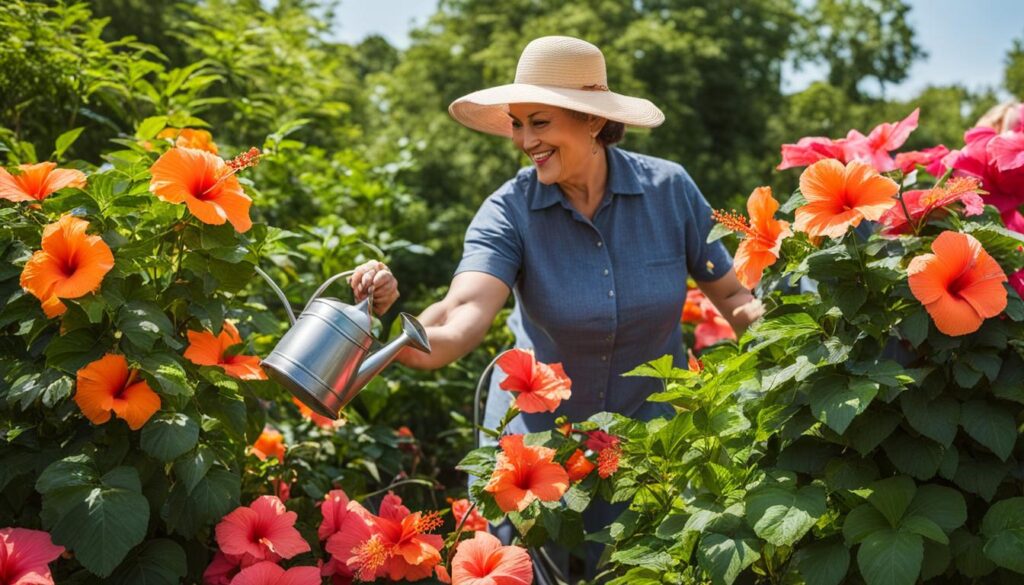
| Common Pests | Identification | Treatment |
|---|---|---|
| Whiteflies | Tiny white insects that fly up when disturbed. | Apply insecticidal soap or neem oil spray regularly. |
| Aphids | Small, soft-bodied insects that cluster on young plant shoots. | Spray with a strong stream of water or use insecticidal soap. |
| Japanese Beetles | Metallic green beetles that feed on leaves, flowers, and buds. | Handpick beetles or use a pyrethrin-based insecticide. |
Hibiscus Care Indoors
Hibiscus plants can also be grown indoors, making them a popular choice for those in colder regions. Bringing hibiscus indoors before the first frost and providing them with enough sunlight is crucial for their indoor care.
“Bringing hibiscus indoors before the first frost and providing them with enough sunlight is crucial for their indoor care.”
To ensure the successful growth and blooming of indoor hibiscus, it is important to follow these essential care tips:
1. Choosing the Right Container
When selecting a container for your indoor hibiscus, opt for a pot with good drainage to prevent waterlogging. Ensure that it is large enough to accommodate the plant’s root system as it grows.
2. Sunlight Requirements
Hibiscus plants require at least six hours of direct sunlight each day to thrive indoors. Place your hibiscus near a south- or west-facing window to provide it with ample sunlight. If natural light is limited, consider supplementing with artificial grow lights.
3. Proper Watering
Keep the soil of your indoor hibiscus evenly moist, but be careful not to overwater. Water thoroughly when the top inch of soil feels dry to the touch and allow excess water to drain out of the pot.
4. Temperature and Humidity
Hibiscus plants prefer temperatures between 60-70°F (15-21°C). Avoid placing them near drafts or heating vents. Maintaining a humidity level of around 50% can also benefit your indoor hibiscus. You can increase humidity by using a humidifier or placing a tray of water near the plant.
5. Fertilization
Feed your indoor hibiscus with a balanced fertilizer once a month during the growing season (spring and summer). Follow the instructions on the fertilizer packaging for proper dosage and application.
6. Winter Care
Hibiscus plants may not flower as abundantly during the winter months, but with the right care, they can still produce blooms. During winter, reduce watering frequency slightly and avoid fertilizing. Maintain a temperature range of 55-65°F (13-18°C) to promote dormancy. If possible, provide supplemental lighting to simulate longer daylight hours.
7. Pruning
Regular pruning helps maintain the shape and health of your indoor hibiscus. Prune during late winter or early spring to remove any dead or leggy growth. Trim back excessive branches to encourage bushier growth.
With proper care, your indoor hibiscus can brighten your home with its vibrant blooms and lush foliage.
References:
- “How to Care for Hibiscus Plants Indoors” – Gardening Know How
- “Indoor Hibiscus Care” – The Spruce
- “Growing Hibiscus Indoors as Houseplants” – The Old Farmer’s Almanac
| Indoor Hibiscus Care Essentials | Tips |
|---|---|
| Container Selection | Choose a pot with good drainage and adequate size. |
| Sunlight Requirements | Provide at least 6 hours of direct sunlight per day. |
| Watering | Keep the soil evenly moist, avoiding overwatering. |
| Temperature and Humidity | Ensure a temperature range of 60-70°F (15-21°C) and maintain humidity around 50%. |
| Fertilization | Fertilize monthly during the growing season with a balanced fertilizer. |
| Winter Care | Reduce watering and avoid fertilizing during winter. Maintain temperatures of 55-65°F (13-18°C). |
| Pruning | Regularly prune during late winter or early spring to maintain shape and encourage bushier growth. |
The Unique Features of HibisQs Varieties
The HibisQs series offers hibiscus enthusiasts a collection of stunning hybrids with exceptional features that make them stand out among other varieties. These unique hibiscus plants are bred to exhibit extraordinary flower size, a wide range of colors, extended blooming periods, and more compact growth habits.
One of the remarkable qualities of HibisQs varieties is their exceptional flower size. The blooms of these hibiscus plants are significantly larger compared to other cultivars, creating a truly eye-catching display in your garden. From vibrant reds and pinks to delicate pastels and pristine whites, the color range of HibisQs varieties is extensive. Whether you prefer bold and vibrant or soft and subtle, there is a HibisQs variety to suit your taste.
What sets the HibisQs series apart is their extended blooming periods. These hybrids have been meticulously bred to prolong their blooming season, allowing you to enjoy their beautiful flowers for a longer time. Whether it’s in the height of summer or well into the fall, HibisQs varieties continue to grace your garden with their remarkable blooms.
Comparison of HibisQs Varieties
| Variety | Flower Size | Color Range | Blooming Period | Compact Growth |
|---|---|---|---|---|
| HibisQs Red Majesty | Large | Red | Summer to Fall | Yes |
| HibisQs Pink Pearl | Medium-Large | Pink | Spring to Fall | Yes |
| HibisQs Golden Sunset | Large | Yellow | Summer to Fall | Yes |
| HibisQs Coral Bliss | Medium | Coral | Spring to Fall | Yes |
The more compact growth habits of HibisQs varieties make them an excellent choice for smaller garden spaces or container gardening. These plants are well-suited for those who desire the beauty of hibiscus but have limited outdoor space.
With their exceptional flower size, wide color range, extended blooming periods, and compact growth habits, HibisQs varieties offer hibiscus enthusiasts an opportunity to create a truly remarkable garden display.
Conclusion
In conclusion, hibiscus plants are a true delight for gardening enthusiasts. With their vibrant blooms and adaptability to different gardening styles, they have become a popular choice for gardens and indoor spaces. By following the essential care tips provided in this article, you can ensure the successful growth and blooming of your hibiscus plants, creating a stunning display of colors in your outdoor or indoor space.
Remember to find the perfect spot for your hibiscus, where it can receive ample sunlight and be planted in well-draining soil. Consistent watering and feeding with a balanced fertilizer will provide the necessary nutrients for optimal growth. Pruning techniques can help shape the plant and encourage healthy growth. Whether you choose to grow hibiscus outdoors or indoors, with proper care, these beautiful plants can bring joy and vibrant beauty to your surroundings.
So, don’t hesitate to bring home some hibiscus plants and experience the wonders of their magnificent blooms. Enjoy the beauty and versatility of hibiscus, and let their splendor brighten up your gardening journey!
Can the Care Tips for Polka Dot Plants also be Applied to Hibiscus Plants?
Yes, the ultimate polka dot plant care tips can also be applied to hibiscus plants. Both plants prefer bright, indirect sunlight, consistent watering, and high humidity. Regular pruning and fertilizing are also important for maintaining the health and vibrancy of both polka dot and hibiscus plants.
FAQ
What are the benefits of hibiscus?
Hibiscus offers numerous benefits, including its vibrant blooms, adaptability to different gardening styles, and its ability to be grown both indoors and outdoors.
How do I care for hibiscus plants?
To care for hibiscus plants, ensure they receive at least six hours of direct sunlight each day, plant them in consistently moist, well-draining soil, and provide regular watering and fertilization during the growing season.
What are the different varieties of hibiscus flowers?
Hibiscus flowers come in a wide range of colors, including red, pink, orange, yellow, and white. Some varieties also have double-layered blooms or intricate patterns.
Can hibiscus plants be grown in containers?
Yes, hibiscus plants can be grown in containers. Make sure to choose a pot with drainage holes to prevent waterlogged soil and provide proper care for container plants.
How do I feed and fertilize hibiscus plants?
Use a balanced, slow-release fertilizer with equal parts nitrogen (N), phosphorus (P), and potassium (K) every 4-6 weeks during the growing season to provide the necessary nutrients for hibiscus plants.
When and how should I prune hibiscus plants?
Prune hibiscus plants in late winter or early spring to remove dead, damaged, or diseased wood. Follow pruning techniques that encourage bushier growth and shape the plant.
How do I care for hibiscus plants outdoors?
Care for hibiscus plants outdoors by providing them with ample sunlight and space to grow, planting them in well-draining soil, protecting them from frost or freezes, and regularly watering and monitoring for common pests.
Can hibiscus plants be grown indoors?
Yes, hibiscus plants can be grown indoors. Bring them indoors before the first frost, provide sufficient sunlight, regularly fertilize, and keep the soil moist without overwatering.
What are the unique features of HibisQs varieties?
HibisQs varieties offer larger flower sizes, a wide range of colors, extended blooming periods, and more compact growth habits. They are perfect for smaller gardens or container gardening.
- About the Author
- Latest Posts
Introducing Ron, the home decor aficionado at ByRetreat, whose passion for creating beautiful and inviting spaces is at the heart of his work. With his deep knowledge of home decor and his innate sense of style, Ron brings a wealth of expertise and a keen eye for detail to the ByRetreat team.
Ron’s love for home decor goes beyond aesthetics; he understands that our surroundings play a significant role in our overall well-being and productivity. With this in mind, Ron is dedicated to transforming remote workspaces into havens of comfort, functionality, and beauty.
Plants
Ideal Hydrangea Spots: Best Place to Plant Hydrangeas
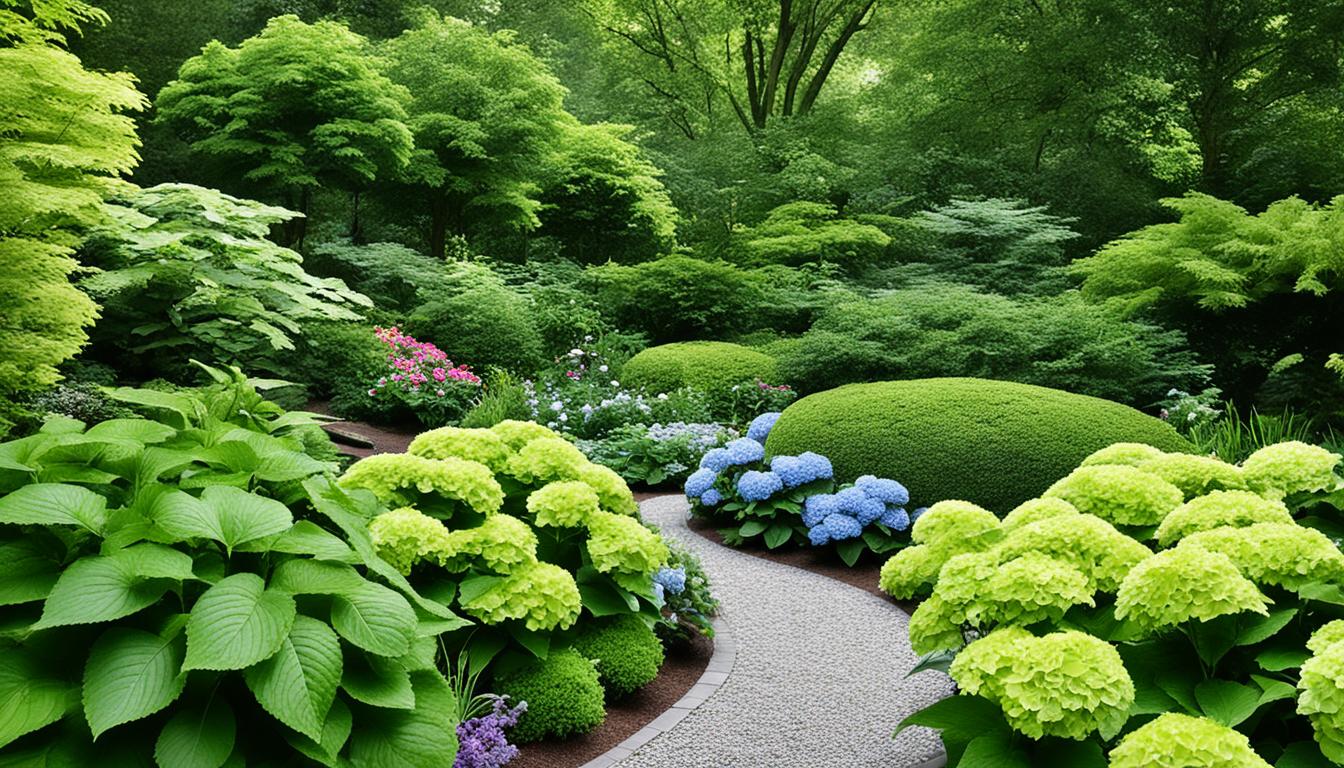
Did you know that the location where you plant your hydrangeas can have a significant impact on their growth and vibrancy? Finding the best place to plant hydrangeas is essential for optimal growth and to ensure that you get the most beautiful blooms.
In this guide, we will explore the different factors to consider when selecting the ideal spot for your hydrangeas. Whether you have a sunny garden or a shady corner, we’ll help you choose the right hydrangea varieties to thrive in various sun and shade conditions. By understanding their sunlight preferences and caring for them properly, you can enjoy vibrant and healthy hydrangea blooms year after year.
Key Takeaways:
- Choosing the right location is crucial for the growth and vibrancy of hydrangeas.
- Hydrangeas can thrive in different sunlight conditions, from full sun to partial shade.
- Consider the specific sunlight needs of different hydrangea varieties for optimal results.
- Proper care, including pruning, fertilizing, and watering, is essential for healthy blooms.
- By following our planting guide and care tips, you can transform your garden with stunning hydrangea displays.
Hydrangeas for Part Shade: Give Us Some Sunblock Please
When it comes to creating the perfect environment for hydrangeas, finding the right balance of sun and shade is key. While some hydrangea varieties thrive in full sun, others prefer a location with partial shade, where they can benefit from the morning sun and enjoy relief from the scorching afternoon rays. These hydrangeas are like beachgoers who know the importance of sunblock, seeking a little shade to protect themselves from the intense heat.
In the family of hydrangeas, there are several popular cultivars that are well-suited for part shade conditions. These varieties have the ability to produce stunning blooms when provided with a combination of filtered light and a few hours of full sun. Among them are the beloved Endless Summer® Hydrangea series, which includes BloomStruck®, Endless Summer®, Blushing Bride®, and Twist-n-Shout®.
Another great choice for morning sun and afternoon shade is the Annabelle Hydrangea, which is known for its spectacular large white flowers. And let’s not forget the many bigleaf hydrangea cultivars that can handle part shade and reward you with their vibrant blossoms.
Here are a few remarkable hydrangea varieties that thrive in part shade:
| Hydrangea Variety | Light Requirements |
|---|---|
| Endless Summer® series (BloomStruck®, Endless Summer®, Blushing Bride®, Twist-n-Shout®) | Morning sun, afternoon shade |
| Annabelle Hydrangea | Morning sun, afternoon shade |
| Bigleaf hydrangea cultivars | Morning sun, afternoon shade |
These hydrangeas have adapted to thrive in part shade by enjoying the gentle morning sun and being sheltered from the intense afternoon heat. This combination of light conditions allows them to produce their enchanting blooms and add a touch of elegance to any garden or landscape.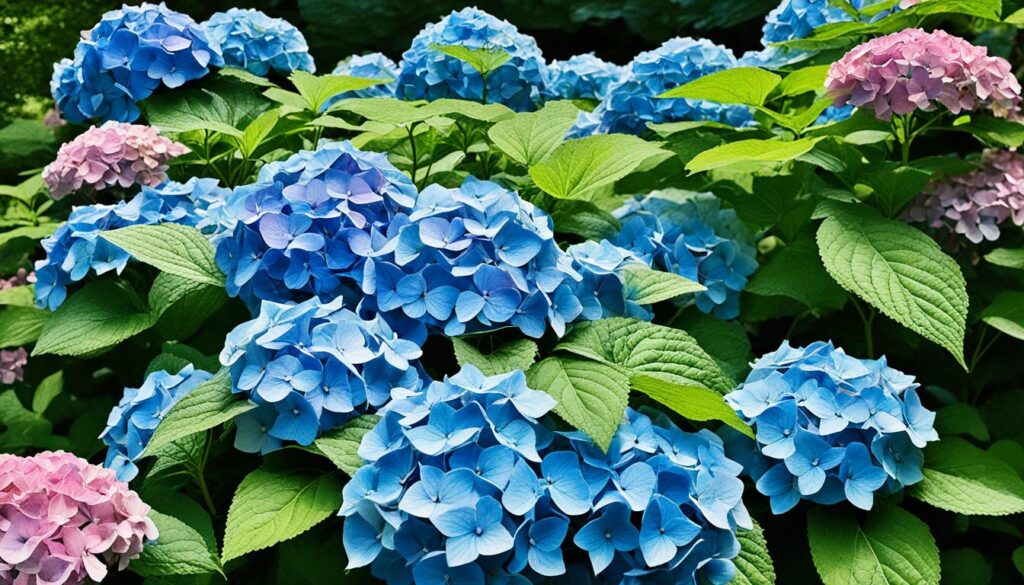
So, if you have a garden or yard with a mix of sunlight and shade, don’t worry! There are plenty of beautiful hydrangeas that will thrive in this environment. Just give them some sunblock (in the form of morning sun) and watch as their blooms light up your space with their breathtaking beauty.
Hydrangeas for Full Sun: We Like It Sunny
While most hydrangeas prefer some shade, there are certain varieties that can thrive in full sun. If your garden gets plenty of sunlight, don’t worry! There are hydrangeas that will flourish in these conditions and reward you with beautiful blooms.
Panicle Hydrangeas
Panicle hydrangeas, known for their cone-shaped flower clusters, are excellent choices for full sun exposure. They can tolerate the direct heat and intense sunlight, making them perfect for sunny spots in your garden. Some popular panicle hydrangeas include:
- Fire Light®
- Limelight
- Pinky Winky®
- Strawberry Sundae®
- Vanilla Strawberry®
Dwarf Varieties
If you have limited space or prefer compact hydrangeas, consider the Let’s Dance® and Cityline® series. These dwarf varieties are perfect for both full sun and part sun environments. They offer the beauty of hydrangeas in a smaller package without compromising on vibrant blooms.
Smooth Hydrangeas
Smooth hydrangeas are another type that can handle full or part sun conditions. These varieties are known for their large rounded flower heads and are a great choice for a sunny garden. Consider the following smooth hydrangeas:
- Incrediball®
- Invincibelle® Ruby
With these hydrangeas, you can enjoy the beauty and charm of these flowering plants even in full sun areas. Just make sure to provide them with proper care and maintenance, including regular watering and occasional fertilization.
Overall, including hydrangeas that thrive in full sun can add a splash of color and vibrancy to your garden. Whether you choose panicle hydrangeas, dwarf varieties, or smooth hydrangeas, these sun-loving beauties will brighten up any sunny corner of your outdoor space.
Growing Hydrangeas in Different Sun and Shade Conditions
When it comes to growing hydrangeas, understanding their sunlight requirements is essential for their success. While many hydrangea varieties thrive in partial shade, oakleaf hydrangeas are known for their adaptability to different sun and shade conditions.
In the northern parts of the United States, oakleaf hydrangeas can tolerate full sun. However, in warmer and southern climates, they prefer some afternoon shade to protect them from excessive heat and sun exposure. This makes them an excellent choice for those looking to plant hydrangeas in regions with varying temperature and sunlight conditions.
What makes oakleaf hydrangeas unique is their ability to also tolerate full shade. This makes them ideal for areas of the garden that receive little to no direct sunlight. Whether it’s a densely shaded corner or underneath taller trees, oakleaf hydrangeas can thrive and add beauty to areas that are typically challenging for other hydrangea varieties.
It’s important to note that while oakleaf hydrangeas are the most adaptable, other hydrangea varieties have specific sunlight needs. When selecting the location for planting, it’s crucial to consider the specific requirements of each hydrangea type to ensure optimal growth and vigor.
By carefully assessing the sunlight conditions in your garden and selecting the appropriate hydrangea varieties, you can create a diverse and captivating display of hydrangeas that thrive in different sun and shade conditions.
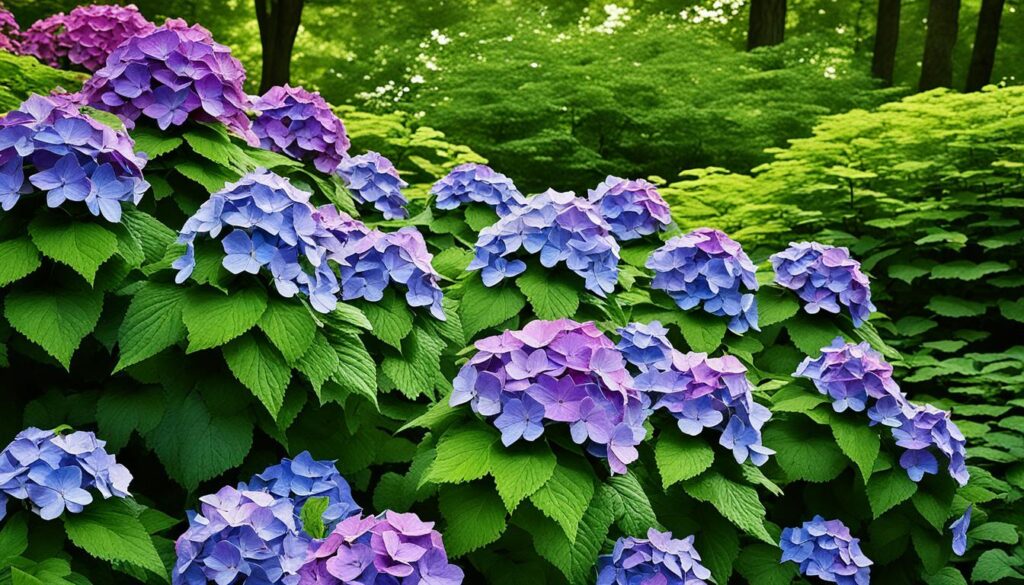
Pruning and Caring for Hydrangeas
Proper pruning and care are essential for the health and vitality of hydrangeas. By implementing appropriate pruning techniques and providing the necessary care, gardeners can ensure the longevity and abundant blooming of their hydrangea plants. Here are some important tips to consider:
Understanding Pruning Methods
When pruning hydrangeas, it’s crucial to understand whether the plant blooms on old wood or new wood. This knowledge will help gardeners avoid accidentally cutting off next season’s flowers.
Tip: Prune hydrangeas that bloom on old wood immediately after flowering. This allows for new growth and development of flower buds for next year. On the other hand, hydrangeas that bloom on new wood can be pruned during late winter or early spring before new growth begins.
Optimal Soil Conditions
Hydrangeas thrive in well-drained soil that is rich in organic matter. A mixture of compost and native soil is ideal for providing the necessary nutrients and moisture retention.
Fertilizing for Healthy Blooms
To promote healthy blooming, it’s recommended to fertilize hydrangeas with a slow-release fertilizer that is high in phosphorus. Phosphorus is essential for promoting flower production and overall plant vitality.
Preventing Leaf Scorch
Hydrangeas are susceptible to leaf scorch, especially during hot and dry periods. To prevent leaf scorch, it’s important to provide hydrangeas with extra water and ensure they have adequate moisture in the soil.

Summary of Pruning and Care Tips
| Pruning Method | Soil Conditions | Fertilizing | Preventing Leaf Scorch |
|---|---|---|---|
| Prune hydrangeas that bloom on old wood immediately after flowering | Well-drained soil with organic compost | Use slow-release fertilizer high in phosphorus | Provide extra water during hot and dry periods |
By following these pruning and care tips, hydrangea enthusiasts can enjoy lush, vibrant blooms year after year. With proper maintenance, these stunning plants will continue to beautify gardens and landscapes.
Conclusion
Planting hydrangeas in the best location and providing proper care and maintenance are key to achieving beautiful and vibrant blooms. By selecting the right spot that balances sun and shade, ensuring well-drained soil, and following recommended pruning and watering practices, gardeners can enjoy the full potential of their hydrangea plants. With the right planting and care, hydrangeas can transform any garden into a colorful and inviting space.FAQ
What is the best place to plant hydrangeas?
What are the best types of hydrangeas for morning sun and afternoon shade?
Can hydrangeas grow in full sun?
Which hydrangea varieties are best for full shade?
How should I prune and care for hydrangeas?
Are there any tips for planting and caring for hydrangeas?
- About the Author
- Latest Posts
Meet Katherine, the creative enthusiast at ByRetreat who infuses her boundless passion for design into every remote workspace she crafts. With an innate sense of creativity and an eye for unconventional beauty, Katherine brings a unique and inspiring perspective to the team.
Katherine’s love for design is infectious, and her ability to think outside the box sets her apart. She believes that true artistry lies in embracing a variety of styles and mixing them harmoniously to create captivating spaces. By combining different textures, colors, and patterns, Katherine weaves a tapestry of creativity that breathes life into each remote workspace.
Plants
Grow Zucchini Successfully: Best Way & Tips

Did you know that zucchini plants are susceptible to squash vine borers, a pest that can quickly kill the plants by cutting off the flow of water? The impact of these destructive borers can be devastating to your zucchini harvest. However, by following the best practices and tips for growing zucchini, you can ensure successful cultivation and enjoy a bountiful harvest.
Whether you are a seasoned gardener or a novice looking to try your hand at gardening, this article will provide you with valuable insights on the best way to grow zucchini and tips for successful cultivation. From avoiding squash vine borers to proper planting techniques, soil requirements, spacing, and pollination, we will cover everything you need to know to grow zucchini successfully.
Key Takeaways:
- Delay planting zucchini until mid-July or use row covers to prevent squash vine borers
- Start zucchini from seeds or seedlings and choose the right time to plant
- Provide well-draining soil enriched with organic material for optimal growth
- Space zucchini plants at least 3-4 feet apart and consider trellising for better air circulation
- Ensure proper pollination for optimal fruit production and harvest zucchini at any size
Planting and Germination
Zucchini, a popular summer squash variety, can be easily grown from seeds or seedlings. While starting zucchini indoors is an option, direct sowing in the ground is the preferred and most common method of planting zucchini seeds. Here’s a step-by-step guide to planting zucchini seeds and ensuring successful germination:
1. Prepare the Soil
Before starting zucchini indoors or sowing the seeds outside, it’s crucial to have well-prepared soil. Ensure the soil is loose, rich in organic matter, and drains well. Incorporating compost or aged manure can greatly improve the soil’s fertility. Measure the soil temperature and wait until it consistently reaches above 55 degrees Fahrenheit for successful germination.
2. Planting Zucchini Seeds
When the soil is ready, plant the zucchini seeds about an inch deep into the soil. Space the seeds at least 3 feet apart to allow ample room for growth. Lightly mist the top of the soil with water to ensure proper moisture levels for the germination of zucchini. Take care not to overwater the seeds, as it can lead to rotting.
Pro Tip: For those who prefer starting zucchini indoors, plant the seeds in peat pots or biodegradable seed starting trays about 2-3 weeks before the last expected frost. Transplant the seedlings outdoors once the soil temperature is suitable.
3. Germination and Thinning
The germination period of zucchini seeds typically ranges from 5 to 10 days. During this time, it’s important to keep the soil consistently moist but not waterlogged. Once the seedlings reach a height of around 3 inches and develop 2 sets of true leaves, it’s time to thin them out. Starting zucchini indoors often leads to more seedlings, so removing the weaker ones will allow the strongest ones to flourish.
4. Timing is Key
For optimal growth, it’s crucial to plant zucchini at the right time. Zucchini thrives in warm soil, so direct sowing should take place in the second half of May when the risk of frost has passed and the soil has warmed up. This timing ensures that the young seedlings will not succumb to cold temperatures.
“Direct sowing zucchini seeds is the most practical and successful method for home gardeners. The plants quickly establish themselves and produce abundant healthy foliage and fruit.” – Gardening Expert, Jessica Washington
By following these planting zucchini seeds and germination guidelines, you can give your zucchini plants a head start in their growth journey. Whether you choose to start the seeds indoors or directly sow them in the ground, with proper care and attention, you’ll soon be rewarded with healthy zucchini plants ready to produce an abundance of delicious squash.
| Benefits of Direct Sowing Zucchini Seeds | Benefits of Starting Zucchini Indoors |
|---|---|
| 1. Simplifies the planting process | 1. Provides an earlier start to the growing season |
| 2. Minimizes transplant shock | 2. Offers more control over seedling development |
| 3. Allows seeds to germinate and grow in their natural environment | 3. Enables better protection against adverse weather conditions |
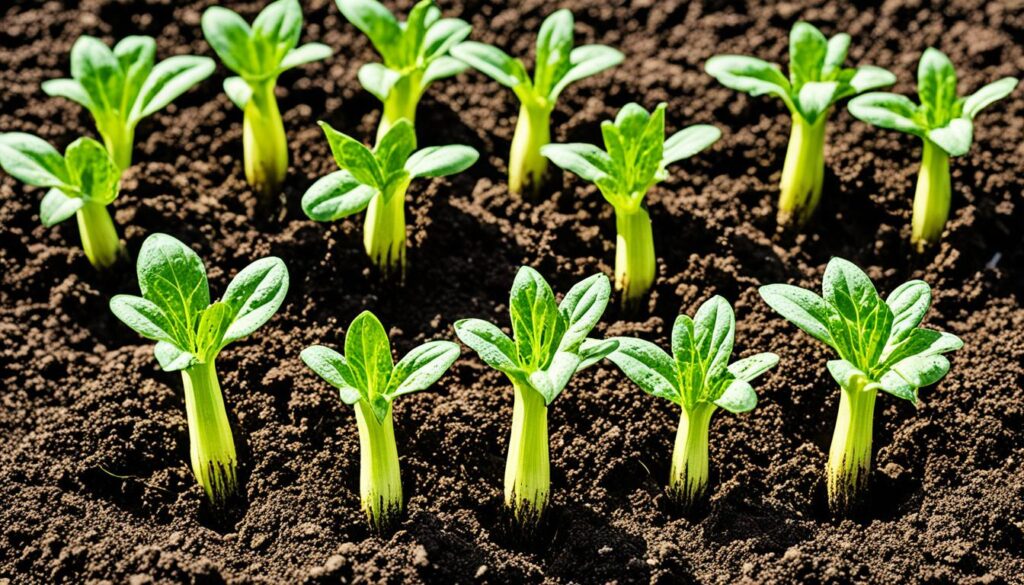
Soil and Location Requirements
Zucchini plants require specific soil and an ideal location to thrive and produce a bountiful harvest. Providing the right conditions for your zucchinis will ensure their health and productivity.
Choosing the Best Soil
Zucchini plants prefer organically rich, fertile, and well-draining soil. When planting in raised beds or containers, it is essential to select a well-draining potting soil. To enhance the soil’s fertility, add organic material or compost at the time of planting. This will help create a nutrient-rich environment for the zucchini plants to thrive.
If you are planting zucchinis directly in the ground, it is crucial to amend the soil with rich organic material or compost. This will improve the soil’s texture and provide the necessary nutrients for the plants to grow strong and healthy. Additionally, good drainage is essential for zucchini plants, as they prefer moist but not waterlogged conditions.
Choosing the Ideal Location
When selecting a location for your zucchini plants, it is important to consider their sunlight requirements. Zucchinis thrive in areas that receive full sun for at least 6-8 hours a day. Choose an area in your garden that is not shaded by buildings or trees, as this can hinder their growth and development.
Furthermore, it is important to note that zucchinis should not be planted in soil where other cucurbits (such as pumpkins or cucumbers) were grown in the past 1-2 years. This practice helps prevent the spread of diseases and pests that may affect the zucchini plants.
By providing the right soil conditions and selecting an ideal location with ample sunlight, you will create an optimal environment for your zucchini plants to flourish and produce an abundant crop.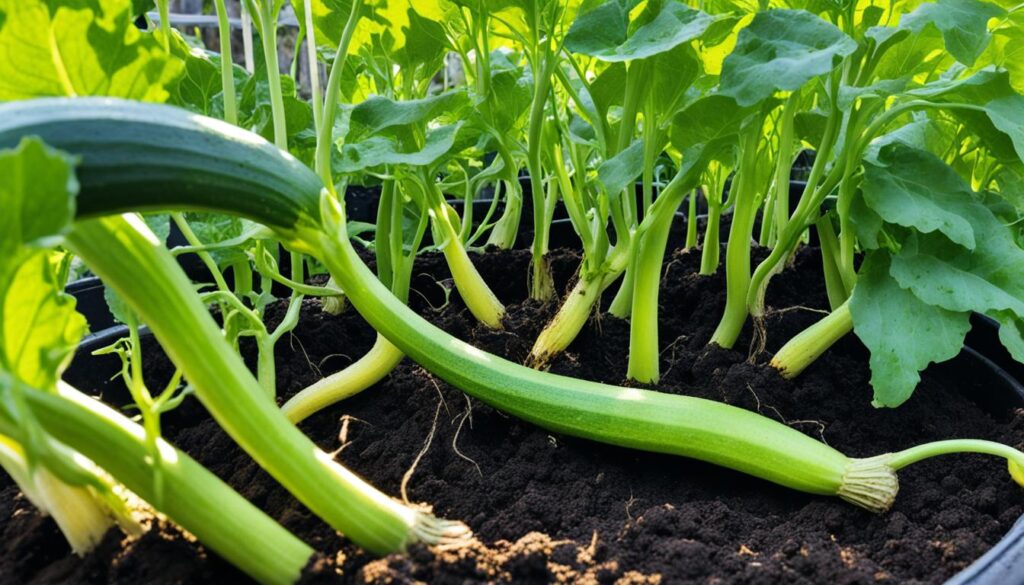
“Zucchini plants prefer organically rich, fertile, and well-draining soil. Provide the right conditions to help your zucchini plants thrive and produce a bountiful harvest.”
Spacing and Trellising
Proper spacing and trellising techniques are essential for the successful growth and development of zucchini plants.
Spacing Zucchini Plants
When it comes to zucchini plant spacing, giving enough room for each plant is crucial for optimal growth. It is recommended to space zucchini plants at least 3-4 feet apart, whether planting them in hills or rows.
For planting in hills, a general guideline is to plant 3 zucchinis per hill in a triangle pattern. Ensure the hills are also spaced 3-4 feet apart to provide enough space for the plants to receive nutrients and expand their root systems.
If growing zucchinis in containers, create a mound in the center of the container and plant three zucchinis around it. This arrangement allows for adequate airflow and efficient use of space while providing the plants with the necessary growing area.
Trellising Zucchini
Another option for maximizing space and aiding in pest management is trellising zucchini plants. By training them to grow vertically along a trellis or stakes, you can create a visually appealing and space-saving garden.
When trellising zucchini, ensure that the trellis or stakes are sturdy enough to support the weight of the plants and their fruit. As the zucchinis grow, gently guide the vines and tendrils toward the trellis, securing them with twist ties or plant clips.
The benefits of trellising zucchini include improved air circulation, which helps prevent disease, easier harvesting, and reduced pest damage since the plants are elevated off the ground.
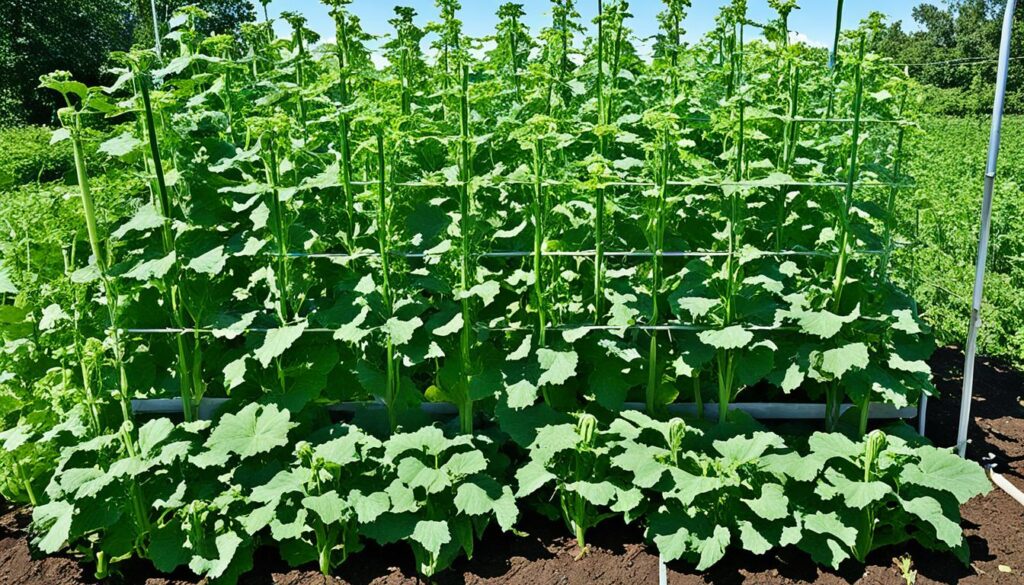
Implementing proper spacing and trellising techniques ultimately promotes healthier zucchini plants, increased productivity, and efficient use of garden space.
Pollination and Fruit Production
Zucchini plants rely on pollination for fruit production. These plants have separate male and female flowers, and the transfer of pollen from the male to the female flowers is crucial for the development of zucchini fruits. To ensure successful pollination, it’s important to understand how pollinators play a role in this process. 
Pollinators such as bees, butterflies, and other insects are attracted to the bright yellow flowers of zucchini plants. To maximize their presence in your garden, consider planting companion flowers like borage, catmint, dill, or dahlias nearby. These flowers will help attract pollinators, increasing the chances of successful pollination.
In some cases, there may be a lack of natural pollination due to factors such as weather conditions or a limited number of pollinators in the area. In such situations, manual pollination can be done to ensure fruit production. This process involves using a small brush or cotton swab to transfer pollen from the male flowers to the female flowers. By gently brushing the inside of the male flower and then transferring the pollen to the stigma of the female flower, you can help facilitate pollination.
Tip: To identify male and female flowers, look for the presence of a small zucchini-shaped swelling at the base of the female flower. Male flowers, on the other hand, do not have this swelling.
Proper pollination is essential for optimal fruit development. It ensures that the female flowers receive the necessary pollen for fertilization, leading to the formation of healthy zucchini fruits. Be sure to monitor the progress of your zucchini plants and check for signs of fruits developing from the female flowers.
When it comes to harvesting zucchini, you can do so at any size. However, larger zucchinis may have more developed seeds and a denser texture, which might not be desirable for certain recipes. In such cases, it is recommended to remove the seeds before consumption. This can be done by slicing the zucchini lengthwise and scooping out the seeds with a spoon.
Conclusion
Successful zucchini cultivation requires attention to several key factors, including avoiding squash vine borers, following proper planting techniques, providing the right soil and location, spacing plants correctly, and ensuring proper pollination. By implementing these tips and techniques, gardeners can enjoy a bountiful harvest of zucchinis that can be incorporated into a wide range of dishes.
The best way to grow zucchini is to start by carefully timing the planting, ensuring that soil temperatures are consistently above 55 degrees Fahrenheit. This warm soil temperature provides an ideal environment for germination and growth. Additionally, choosing a well-lit area with full sun for at least 6 hours a day will help zucchinis thrive.
When it comes to soil and location requirements, zucchini plants prefer organically rich and well-draining soil. Amend the soil with compost or rich organic material to promote healthy growth. Adequate spacing is essential for proper plant development, with a recommended distance of 3-4 feet between plants. Trellising zucchini plants can also save space and improve airflow.
Finally, ensuring proper pollination is crucial for maximizing fruit production. Planting companion flowers near zucchinis can attract beneficial pollinators, and manual pollination can be done to supplement natural pollination. Harvesting can be done at any size, but larger zucchinis may require seed removal before consumption.FAQ
When is the best time to plant zucchini?
How can I prevent squash vine borers from killing my zucchini plants?
What type of soil do zucchini plants prefer?
How should I space my zucchini plants?
Do zucchini plants require manual pollination?
Can I grow zucchini vertically?
- About the Author
- Latest Posts
Meet Katherine, the creative enthusiast at ByRetreat who infuses her boundless passion for design into every remote workspace she crafts. With an innate sense of creativity and an eye for unconventional beauty, Katherine brings a unique and inspiring perspective to the team.
Katherine’s love for design is infectious, and her ability to think outside the box sets her apart. She believes that true artistry lies in embracing a variety of styles and mixing them harmoniously to create captivating spaces. By combining different textures, colors, and patterns, Katherine weaves a tapestry of creativity that breathes life into each remote workspace.
Plants
Best Conditions for Ginger Root Growth Explained
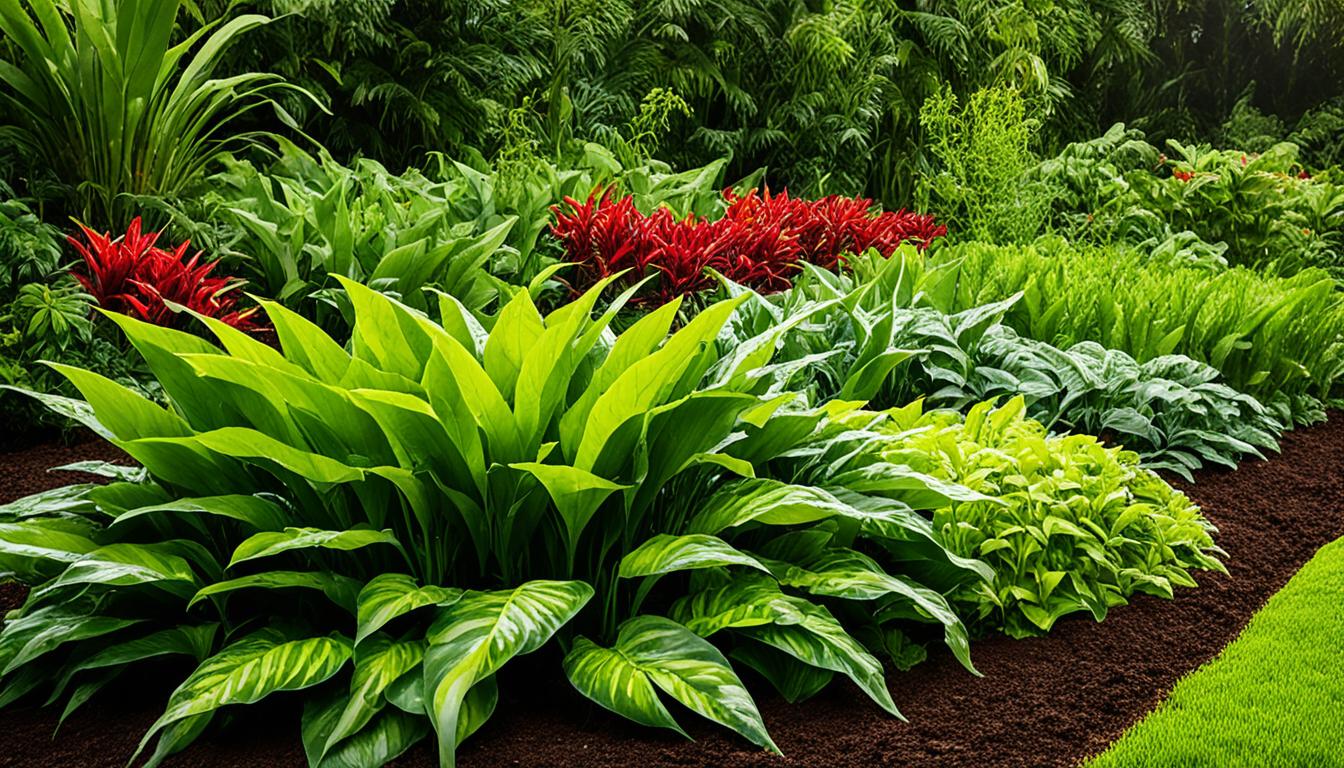
Ginger, known for its unique flavor and medicinal properties, is a versatile root used in everything from cooking to herbal remedies. But did you know that the success of ginger cultivation depends heavily on the conditions in which it is grown? Creating the best conditions for ginger root growth is essential to yield a bountiful harvest and vibrant plants.
From temperature to soil quality and moisture levels, each aspect plays a crucial role in ginger’s growth and well-being. By understanding the optimal conditions, gardeners and enthusiasts can replicate ginger’s tropical habitat and cultivate healthy plants with exceptional flavor and aroma.
In this article, we will explore the optimal conditions necessary for ginger root growth, offering insights and techniques to help you grow ginger successfully. Whether you’re an experienced gardener or a beginner with a green thumb, this guide will provide valuable knowledge to enhance your ginger cultivation.
Key Takeaways:
- Ginger root growth requires specific conditions to thrive.
- Temperature, soil quality, moisture, and shade are essential factors.
- Best practices include using organic matter, maintaining proper drainage, and providing dappled shade.
- Ginger can be grown in containers, hoop houses, or greenhouses.
- Pre-sprouting ginger indoors can maximize the growing season.
Optimal Soil Conditions for Ginger Root Growth
Ginger plants require optimal soil conditions to thrive and produce healthy root growth. By providing the right environment, gardeners can ensure that their ginger plants receive the necessary nutrients and support for robust growth. Here are some essential factors to consider when creating optimal soil conditions for ginger root growth:
- Rich in Organic Matter: Ginger prefers soil that is rich in organic matter, which provides essential nutrients and promotes healthy root development. Adding lots of compost to the ground or using a peat and wood bark-based soilless medium mixed with sand in containers can help create a fertile growing medium.
- Organic Fertilizers and Worm Castings: Supplementing the soil with organic fertilizers and worm castings can further enhance the nutrient content, ensuring that ginger plants have access to the necessary elements for their growth. These natural amendments provide a slow-release source of nutrients, promoting long-term plant health.
- Good Drainage: It is crucial to ensure good drainage in the soil to prevent waterlogging, as standing water can negatively affect ginger growth. To improve drainage, incorporating coarse sand or perlite into the soil can help create a well-draining environment for the roots.
- pH Levels: Maintaining the right pH levels is essential for optimal ginger growth. Ginger plants prefer slightly acidic soil, with pH levels between 5.5 and 6.5. Testing the soil’s pH and making appropriate adjustments using organic soil amendments or sulfur can help create the ideal conditions for ginger plants.
By creating soil conditions that are rich in organic matter, well-draining, and with the right pH levels, gardeners can provide the optimal environment for ginger root growth. The next section will explore the ideal temperature range for ginger plants and the impact it has on their growth and development.
Soil Conditions for Ginger Root Growth
| Soil Condition | Description |
|---|---|
| Rich in organic matter | Ginger prefers soil that is rich in organic matter, such as compost or a peat and wood bark-based soilless medium mixed with sand. |
| Organic fertilizers and worm castings | Adding organic fertilizers and worm castings can provide essential nutrients for ginger plants. |
| Good drainage | Ensuring good drainage in the soil is crucial to prevent waterlogging, which can negatively affect ginger growth. |
| pH levels between 5.5 and 6.5 | Maintaining slightly acidic soil with pH levels between 5.5 and 6.5 is ideal for ginger plants. |

Ideal Temperature Range for Ginger Root Growth
Ginger is a tropical plant that thrives in warm temperatures, making the ideal temperature range a crucial factor for its successful growth. The ideal temperature range for ginger root growth is 70° to 90°F (21° to 32°C). This range provides the optimal conditions for ginger plants to thrive and produce healthy rhizomes.
When growing ginger, it is important to consider the nighttime temperatures as well. It is recommended to plant ginger when nighttime temperatures are consistently above 55°F (13°C). Cooler temperatures can slow down the growth of ginger plants or even cause damage to them, hindering their development.
In regions with colder climates, it may be challenging to maintain these ideal temperatures for ginger growth. However, there are ways to overcome this obstacle and still grow ginger successfully. Growing ginger indoors in a controlled environment, such as a greenhouse or conservatory, can provide the necessary warmth for ginger plants to thrive.
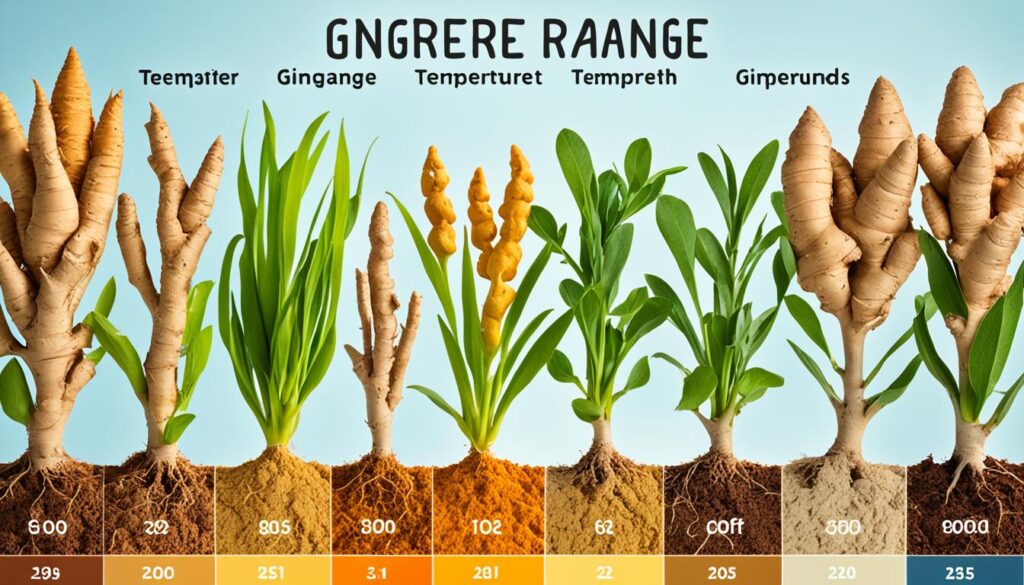
Importance of Moisture for Ginger Root Growth
Ginger is a moisture-loving plant that requires consistent watering to thrive and produce healthy and flavorful roots. Proper moisture management is essential for ginger root growth.
The soil should be kept evenly moist, providing enough water to meet the plant’s needs without overwatering or allowing the soil to dry out completely. Overwatering can lead to waterlogged conditions, which can suffocate the roots and promote the development of root rot. Conversely, letting the soil dry out completely can cause stress to the plant and hinder its growth.
Watering frequency may vary depending on factors such as the climate, humidity levels, and container size. In general, it is advisable to water ginger plants whenever the top inch of soil feels slightly dry. This allows for proper hydration without risking waterlogging.
Proper irrigation techniques and good drainage are crucial for maintaining the ideal moisture levels for ginger root growth. In containers, ensure that there are drainage holes to prevent water from pooling at the bottom. For in-ground planting, selecting a well-draining soil or amending the soil with organic matter can improve moisture balance.
Expert Tip:
When watering ginger plants, it’s important to give them a deep soak, allowing the water to penetrate the root zone. However, avoid overhead watering as it can lead to the development of fungal diseases. Instead, direct the water towards the base of the plant or use a drip irrigation system to ensure precise watering.
By maintaining the right moisture levels through proper watering techniques and good drainage, gardeners can provide the optimal conditions for ginger root growth, ensuring healthy plants and a bountiful harvest.

Moisture Guidelines for Ginger Root Growth
| Moisture Level | Signs | Recommended Action |
|---|---|---|
| Soggy or Waterlogged | Wilting, yellowing leaves; foul odor; root rot | Improve drainage by adding organic matter; reduce watering frequency |
| Too Dry | Wilting, dry soil; slow growth | Increase watering frequency; mulch around plants to retain moisture |
| Evenly Moist | Healthy foliage; steady growth | Continue regular watering; monitor moisture levels |
Benefits of Dappled Shade for Ginger Root Growth
Ginger plants thrive in dappled shade, which provides them with a balanced environment for optimal growth. The benefits of dappled shade include protection from direct sunlight, prevention of soil overheating and excessive drying, and maintenance of suitable moisture levels.
Planting ginger under the shelter of taller crops or using shade cloth can create the perfect conditions for ginger root growth. The dappled shade allows the plants to receive filtered sunlight, which is essential for photosynthesis while reducing the risk of sunburn or heat stress.
“Dappled shade is like a natural sunscreen for ginger plants, shielding them from the harsh rays of the sun and maintaining a cool, comfortable environment.”
By providing dappled shade, you can create an ideal microclimate for ginger root growth. The shade helps regulate soil temperatures, preventing it from becoming too hot and drying out too quickly. This is particularly important for ginger, as it prefers consistently moist soil.
Moreover, dappled shade helps to reduce water evaporation, allowing the roots to stay moist for longer periods. This helps the ginger plants establish a strong root system and absorb essential nutrients from the soil, promoting healthy growth and development.
When setting up dappled shade for your ginger plants, it is important to strike a balance. While providing shade, ensure that there is still enough light penetration for proper photosynthesis. Ginger plants need adequate sunlight to produce energy for growth, but too much direct sunlight can be detrimental.
Consider planting ginger in an area where it receives morning sun and partial afternoon shade. This allows the plants to benefit from the warmth and light of the morning sun while being shielded from the intense heat of the afternoon sun.
To summarize, dappled shade provides numerous benefits for ginger root growth, including protection from direct sunlight, prevention of soil overheating and excessive drying, and maintenance of suitable moisture levels. By implementing dappled shade techniques, you can create an ideal environment for ginger plants to thrive and produce a bountiful harvest.
Pros and Cons of Dappled Shade for Ginger Root Growth
| Benefits of Dappled Shade | Considerations for Dappled Shade |
|---|---|
| Protection from direct sunlight | Ensure there is still enough light for photosynthesis |
| Prevents soil overheating | Find a balance between shade and sunlight |
| Reduces soil drying out | Choose an area with morning sun and partial afternoon shade |
| Maintains suitable moisture levels |

Recommended Planting Techniques for Ginger Root Growth
When it comes to cultivating ginger, selecting the right planting technique is crucial for successful root growth. Whether using whole rhizomes or cut pieces, understanding the proper methods will optimize your ginger harvest. Here are some recommended planting techniques:
1. Using Whole Rhizomes
Planting ginger with whole rhizomes is a straightforward technique that yields excellent results. Look for healthy, plump rhizomes with well-developed buds or eyes. These larger rhizomes tend to grow quicker and produce more robust plants.
To plant whole rhizomes:
- Prepare the soil by loosening it with a garden fork or tiller.
- Dig a trench that is about 6 to 8 inches deep.
- Place the rhizomes in the trench with the eyes facing upwards.
- Cover the rhizomes with soil, ensuring they are well-buried but not too deep.
- Water gently to settle the soil.
2. Using Cut Rhizome Pieces
If you have limited planting material or want to maximize your ginger yield, using cut rhizome pieces is a viable option. When cutting the rhizomes, ensure each piece has at least one bud or eye.
To plant cut rhizome pieces:
- Prepare the soil or select a suitable container with good drainage.
- Fill the container with a well-draining potting mix or amend the soil with organic matter.
- Place the cut rhizome pieces in the soil or container, burying them about 1 to 2 inches deep.
- Water thoroughly to encourage root establishment.
Note: Make sure there is adequate room for the rhizomes to grow when planting in containers. This will prevent overcrowding and promote healthier plant development.
3. Pre-sprouting Indoors
For gardeners who wish to extend the growing season or gain a head start on ginger production, pre-sprouting indoors is an effective technique. This method involves placing the rhizomes in a tray with moist compost or paper towel to encourage early sprouting.
To pre-sprout ginger indoors:
- Select healthy rhizomes with visible eyes.
- Fill a tray with moist compost or lay paper towels on a flat surface.
- Place the rhizomes on the compost or paper towels, positioning them with the eyes facing upwards.
- Maintain the moisture level by misting regularly.
- Keep the tray or paper towels in a warm location with indirect sunlight.
- Once sprouts have developed, carefully transplant them into individual containers or directly into the ground.
Pre-sprouting allows for an earlier harvest and ensures that the ginger plants have a strong start before being exposed to outdoor conditions.
Remember, ginger responds well to a warm and humid environment, so providing the optimal conditions during the planting process will contribute to its overall growth and development.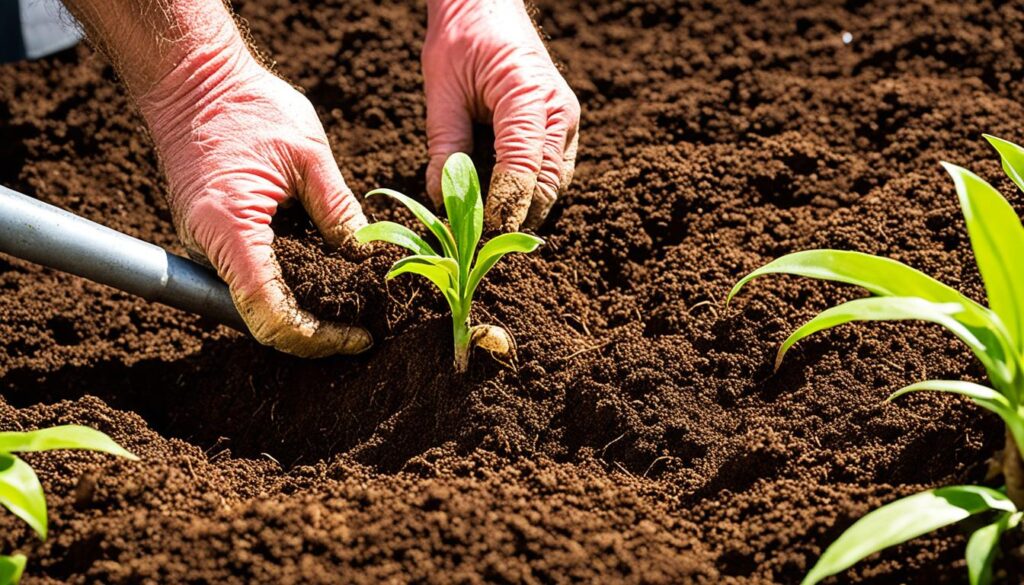
| Planting Technique | Advantages | Disadvantages |
|---|---|---|
| Using Whole Rhizomes | – Quicker growth – Larger harvests |
– Requires more planting material – Limited control over spacing |
| Using Cut Rhizome Pieces | – Maximizes planting material – Allows for precise spacing |
– Slower initial growth – Smaller rhizome yields |
| Pre-sprouting Indoors | – Provides an early start – Enhances germination rates |
– Requires additional indoor space – Requires regular misting |
Care Tips for Ginger Root Growth
Proper care is crucial for the successful growth of ginger roots. By providing the right conditions, you can ensure healthy plants and a bountiful harvest. Here are some essential care tips for ginger root growth:
1. Warmth: Ginger plants thrive in warm environments, so it’s important to provide them with a suitable temperature. During the summer, whether you are growing ginger outdoors or indoors, it’s beneficial to place the plants in a warm and humid area.
2. Humidity: Humidity is another important factor for ginger root growth. If you are growing ginger indoors, placing the plant near a bright windowsill can help simulate the ideal conditions. Additionally, occasional misting with water can create a humid environment that mimics the plant’s natural habitat.
3. Moisture: Adequate moisture levels are essential for ginger plants. It’s important to water the plants regularly, ensuring that the soil is evenly moist. However, be cautious not to overwater, as excessive moisture can lead to root rot. To promote proper drainage, use pots with drainage holes and allow the soil to dry out slightly between waterings.
4. Mulching: Applying a layer of mulch around ginger plants can serve multiple benefits. Mulching helps to conserve moisture in the soil, reducing the frequency of watering required. Additionally, it helps to suppress weed growth, keeping the area around the ginger plants clean and tidy.
Ginger plants require a combination of warmth, humidity, moisture, and proper drainage to thrive. By following these care tips, you can create optimal conditions for ginger root growth and enjoy a successful harvest.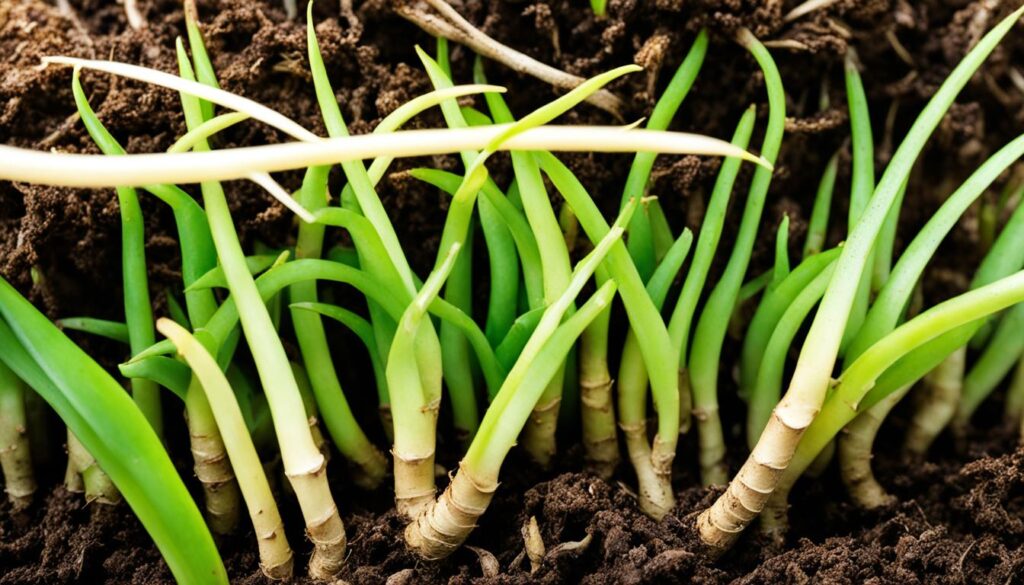
| Care Tips for Ginger Root Growth | Benefits |
|---|---|
| Provide warmth | Creates a favorable environment for ginger plants |
| Maintain humidity | Simulates the plant’s natural habitat and supports growth |
| Ensure proper moisture | Prevents drying out or waterlogging |
| Use mulch | Conserves moisture and suppresses weed growth |
Conclusion
Growing ginger successfully requires replicating its tropical natural habitat as closely as possible. Providing optimal soil conditions, the right temperature range, adequate moisture, and dappled shade is crucial. By following these best practices, gardeners can ensure the best conditions for ginger root growth and enjoy a bountiful harvest.
When it comes to planting ginger, there are two main methods: using whole rhizomes or cutting them into pieces and pre-sprouting indoors for an earlier harvest. Both approaches can be effective, but it’s important to pay careful attention to watering and drainage. Ginger cannot tolerate standing water or drying out completely, so finding the right balance is key.
Remember that ginger thrives in warm temperatures, ideally ranging from 70° to 90°F (21° to 32°C). Additionally, ginger plants appreciate some dappled shade, as it protects them from direct sunlight and helps prevent the soil from drying out too quickly. Creating these optimal conditions will give your ginger the best chance to grow and thrive.
So whether you’re growing ginger in the ground, in containers, or in a greenhouse, make sure to provide it with the right environment. By replicating its tropical natural habitat as closely as possible and paying attention to its specific needs, you can enjoy a bountiful harvest of delicious and aromatic ginger roots.
FAQ
What are the best conditions for ginger root growth?
What are the optimal soil conditions for ginger root growth?
What is the ideal temperature range for ginger root growth?
How important is moisture for ginger root growth?
What are the benefits of dappled shade for ginger root growth?
What are the recommended planting techniques for ginger root growth?
What are the care tips for ginger root growth?
- About the Author
- Latest Posts
Meet Katherine, the creative enthusiast at ByRetreat who infuses her boundless passion for design into every remote workspace she crafts. With an innate sense of creativity and an eye for unconventional beauty, Katherine brings a unique and inspiring perspective to the team.
Katherine’s love for design is infectious, and her ability to think outside the box sets her apart. She believes that true artistry lies in embracing a variety of styles and mixing them harmoniously to create captivating spaces. By combining different textures, colors, and patterns, Katherine weaves a tapestry of creativity that breathes life into each remote workspace.
-

 Mardi Gras Decoration4 weeks ago
Mardi Gras Decoration4 weeks agoWhen Should I Decorate for Mardi Gras?
-

 Vetted2 weeks ago
Vetted2 weeks agoBest Mop for Sparkling Clean Floors in 2024
-

 Christmas Decoration4 weeks ago
Christmas Decoration4 weeks agoDoes Orthodox Christmas Have Santa?
-

 Christmas Decoration4 weeks ago
Christmas Decoration4 weeks agoWhat Happened to Christopher Radko?
-

 Christmas Decoration4 weeks ago
Christmas Decoration4 weeks agoWhat Is Coptic Christmas Day?
-

 Christmas Decoration3 weeks ago
Christmas Decoration3 weeks agoWhy Do Orthodox Have Christmas on January 7th?
-

 Carnival Decoration3 weeks ago
Carnival Decoration3 weeks agoHow Tall Should a Balloon Column Be?
-

 Carnival Decoration3 weeks ago
Carnival Decoration3 weeks agoWhat Food Is Served at a Circus






























